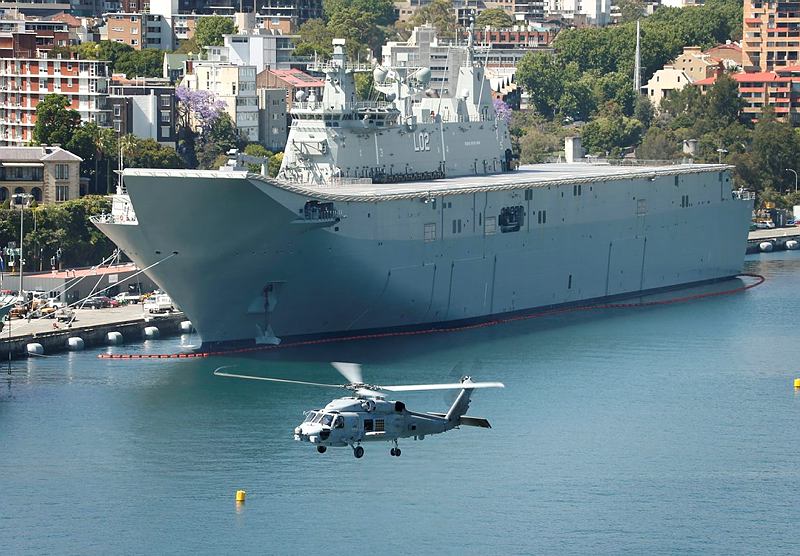ADF Capability snapshots—part 2: RAN
Posted By Andrew Davies on November 12, 2015 @ 06:00
This week’s release in the ADF capability snapshot series takes a look at the Royal Australian Navy [2]. (Here’s a link to last week’s RAAF paper [3].) Again, there’s a lot more good news than bad in this survey. That’s particularly encouraging, because Navy wasn’t in a great place when we did the previous capability snapshot [4] in 2010. So before getting to the good news, let’s set the time machine for 2010 to remind ourselves how things looked then.
The surface combatant fleet was the one bright spot, after the upgrade to the Adelaide class frigates was (eventually) completed. The 2010 review also noted good progress on upgrading the Anzac frigates with a new Saab combat system and Australian-developed CEAFAR radar. That was a good call; the new review notes that, in terms of air defence, the Anzacs are probably the most capable 3,000 tonne vessels in the world today. (A less good call was the statement that the air warfare destroyers would be in service in 2014—the first of those is now expected in late 2017.)
But elsewhere the trend in capability was downwards, including some key force elements. Submarine availability and manning were both problems, resulting in operational submarine days being in short supply. The Navy was also struggling to maintain the old Bravo model Seahawks and their increasingly obsolete systems. The failure of the lightweight torpedo program to provide an air launched weapon and the cancellation of the Super Seasprite meant that the Navy’s combat helicopter capability simply wasn’t up to scratch.
A consequence of those collective shortcomings was that the ADF’s anti-submarine warfare (ASW) capability continued to decline. And with the benefit of hindsight, we could’ve added to the list of problems the hollow nature of the amphibious capability, which effectively collapsed in 2011 when the Navy had no available ships to assist [5] in the response to Cyclone Yasi.
But that was then and this is now and the Navy has made good progress in remediating those issues. The 24 new Romeo model Seahawks have started to deliver real capability to the fleet’s combat helicopter fleet, including a dipping sonar (for the first time in 20 years) and a lightweight ASW torpedo that’s much more capable against modern submarines than the old ones. These are good steps in rebuilding a modern ASW capability, although the final components won’t be in place until the future frigates come on line, probably around the middle of next decade; as good as the Anzacs are above the water, they aren’t as capable beneath it.
The availability of Collins class submarines, which we’ve been tracking [6], has increased substantially since its 2009–10 low point, when the six boats produced only 380 days of availability, and at one stage no submarines were available for operational tasking. While the current figure of around 800 days falls well short of the Coles report benchmark of 1,200 days, it shows that some serious attention is being given to management of this expensive national asset. HMAS Farncombe is the latest boat to go through deep maintenance, and ASC is on schedule to complete the process in well under two years [7]. In comparison, previous overhauls generally took three years, and HMAS Rankin was laid up for almost five years [8] and HMAS Sheean for four.
The Canberra class LHD amphibious ships provide a quantum leap in capability and capacity compared to their predecessors. A single LHD can embark as many troops and more vehicles and equipment than the previous three ships combined. With this acquisition the RAN moves into the front ranks of naval amphibious capability in the region. Of course, there’s a resources bill to be paid for such capability, and getting the Army/Navy combination working smoothly to take advantage of the new capability will be a challenge.
Looking ahead, it’ll be interesting to see how the Abbott government’s promise to bring forward the major and minor vessel shipbuilding projects [9] plays out. The frigates have got most of the press, but the pressing need is actually the minor vessels. The rate of effort required to keep up border patrol work over the past few years, often in pretty tough conditions, has taken its toll on the Armidale class patrol boats. And the Huon class minehunters have also often been pressed into service at the maritime border, to the point where the Navy’s minehunting capability is marginal.
All in all, Navy has made great strides in the past five years. Some smart acquisitions have helped, but there’s also been a better focus on managing the fleet and its people, and in working with industry to bring the various elements of capability together. There’s plenty of work to do, and the future submarine, minor vessel and frigate projects will require plenty of attention, but credit where it’s due.
Article printed from The Strategist: https://www.aspistrategist.org.au
URL to article: https://www.aspistrategist.org.au/adf-capability-snapshots-part-2-ran/
URLs in this post:
[1] Image: http://www.aspistrategist.org.au/wp-content/uploads/2015/11/2014114ran8109938_773.jpg
[2] takes a look at the Royal Australian Navy: https://www.aspi.org.au/publications/adf-capability-snapshot-2015-part-2-ran
[3] RAAF paper: http://www.aspistrategist.org.au/adf-capability-snapshots-part-1-raaf/
[4] previous capability snapshot: https://www.aspi.org.au/publications/navy-capability-review-2010-by-andrew-davies
[5] had no available ships to assist: http://www.abc.net.au/lateline/content/2011/s3272313.htm
[6] tracking: http://www.aspistrategist.org.au/collins-submarine-availability-on-track-but-under-wraps/
[7] complete the process in well under two years: http://www.asc.com.au/en/News-Media/Latest-News/ASC-on-a-roll-with-submarine-maintenance/
[8] laid up for almost five years: http://www.theage.com.au/national/two-subs-out-of-action-for-9-years-20100210-nsgh.html
[9] bring forward the major and minor vessel shipbuilding projects: http://www.minister.defence.gov.au/2015/08/04/joint-media-release-prime-minister-and-minister-for-defence-the-governments-plan-for-a-strong-and-sustainable-naval-shipbuilding-industry/
Click here to print.
